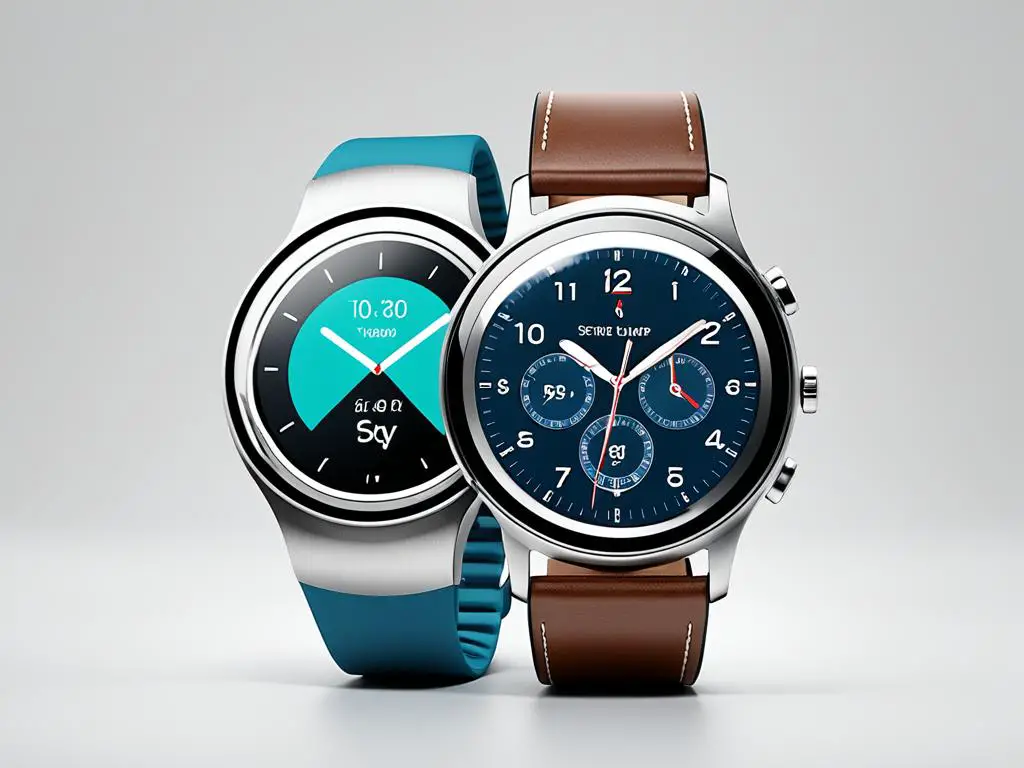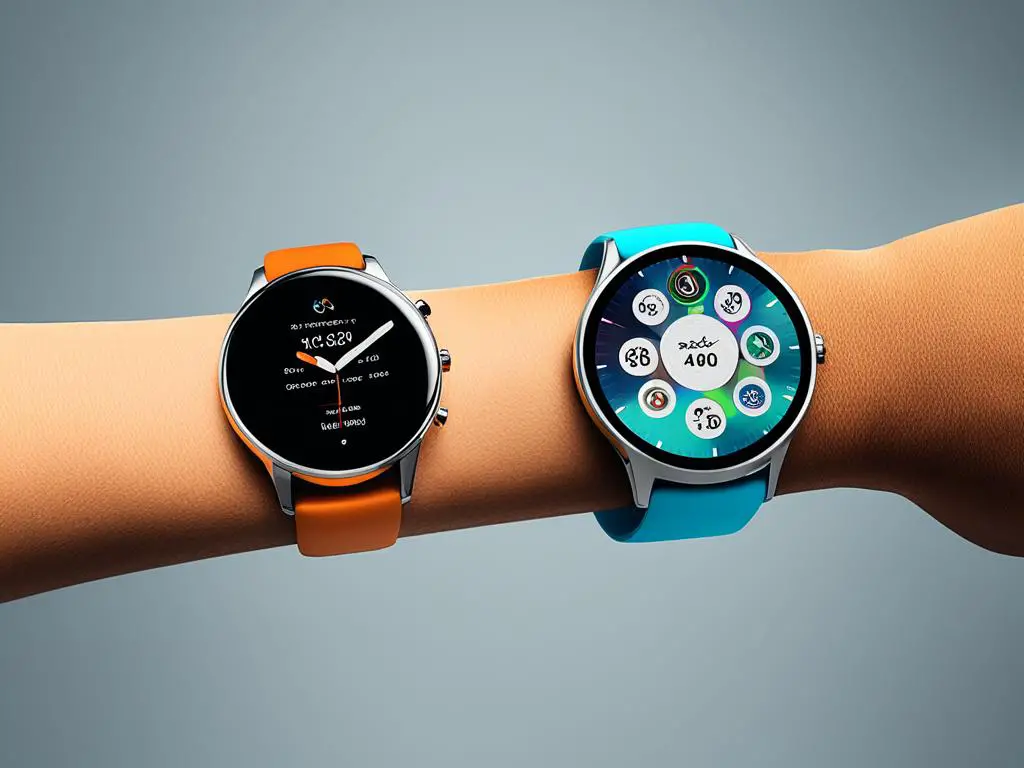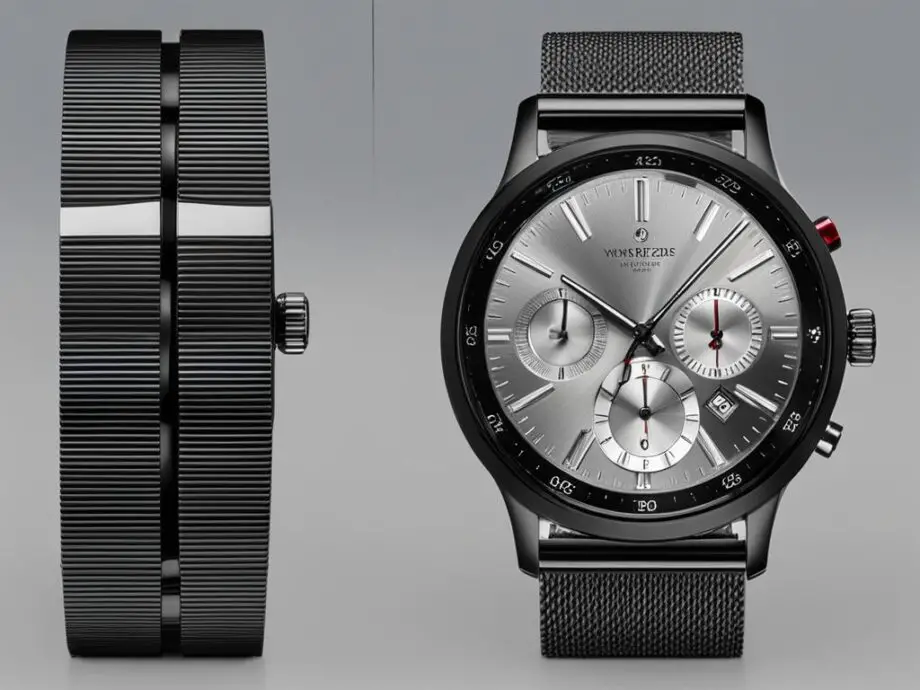Are you torn between choosing a 38mm or a 40mm watch? Worry not, as we’ve got you covered! In this article, we will delve into the differences between these two popular watch sizes, offering you a comprehensive comparison to help you make an informed decision.
When selecting a watch, size matters. It not only affects the overall aesthetics but also determines how comfortable the watch feels on your wrist. Understanding the variations between 38mm and 40mm watches is crucial in finding the perfect fit for your needs.
Let’s dive into the details and explore the dimensions and features of these watch cases.
Key Takeaways:
- The 38mm and 40mm watches are both popular choices in the market.
- Consider your wrist size and personal preferences when selecting a watch size.
- 38mm watches are compact and versatile, suitable for those who prefer a smaller profile.
- 40mm watches offer a slightly larger presence and may be more desirable for individuals with larger wrists.
- Both sizes come with their own advantages and drawbacks, so take your time to weigh them before making a decision.
Understanding Watch Sizes
When it comes to choosing a watch, the size of the timepiece plays a crucial role in both its aesthetics and comfort. Whether you have a small wrist or a larger one, finding the best watch size for your needs is essential. In this section, we will explore the factors you should consider, provide a watch sizing guide, and highlight the key differences in dimensions between 38mm and 40mm watches.
Factors to Consider
When determining the ideal watch size, two main factors should be taken into account: wrist size and personal preference. Your wrist size will directly impact how the watch looks and feels on your arm. For individuals with smaller wrists, wearing a watch that is too large can appear disproportionate and uncomfortable. On the other hand, a watch that is too small may seem underwhelming on a larger wrist.
Personal preference is also crucial as it reflects your individual style and taste. Some individuals prefer oversized statement watches, while others prefer a more subtle and understated look. It’s essential to consider your lifestyle and the occasion for which you’ll be wearing the watch. A dress watch for formal events may require a more delicate size than a sports watch designed for durability and functionality.
Watch Sizing Guide
To determine the best watch size for your wrist, follow these simple guidelines:
- Measure your wrist circumference using a flexible measuring tape or a piece of string.
- If you used a string, measure the length with a ruler to obtain your wrist size in inches or centimeters.
- Refer to the following table to find the recommended watch size based on your wrist measurement.
Differences in Dimensions: 38mm vs 40mm Watches
While the differences between 38mm and 40mm watches may seem minimal, they can have a significant impact on the overall look and fit. Let’s explore the key contrasts in dimensions between these two popular watch sizes:
| Dimensions | 38mm Watch | 40mm Watch |
|---|---|---|
| Case Diameter | 38mm | 40mm |
| Case Thickness | Varies based on the brand and model | Varies based on the brand and model |
| Strap Width | Varies based on the brand and model | Varies based on the brand and model |
| Overall Weight | Varies based on the brand and model | Varies based on the brand and model |
As shown in the table, the primary difference between 38mm and 40mm watches lies in their case diameter. The case thickness, strap width, and overall weight can vary based on the specific brand and model.
Now that we have delved into the ins and outs of watch sizes and the differences between 38mm and 40mm watches, you are equipped with the knowledge to make an informed decision. In the next sections, we will dive deeper into 38mm and 40mm watches, exploring their unique features and suitability for different purposes.
Exploring 38mm Watches
When it comes to choosing the right watch size, the dimensions of the watch face play a crucial role. In this section, we will closely examine 38mm watches and all the essential details you need to know before making a decision. Let’s dive in!
The Advantages of 38mm Watches
One of the key advantages of 38mm watches is their compact and sleek design. These watches are perfect for individuals with smaller wrists or those who prefer a more understated look. The smaller size lends itself well to a variety of occasions, making it suitable for both formal and casual settings.
Additionally, 38mm watches often have a lightweight construction, making them comfortable to wear throughout the day. Their smaller dimensions and reduced weight make them less likely to feel bulky or cumbersome, ensuring a seamless experience on your wrist.
Compatibility with Smartwatches
In today’s world, smartwatches have become an essential accessory for many individuals. If you are considering a smartwatch in the 38mm size range, you’ll be pleased to know that they offer a plethora of features and functionalities, just like their larger counterparts.
38mm smartwatches provide a perfect balance between style and technology. They offer a compact and elegant design while still offering a vibrant and informative watch face. You can stay connected, track your fitness goals, and enjoy various other smart features without compromising on aesthetics.
Watch Face Size and Overall Dimensions
When it comes to the watch face size, 38mm watches typically boast a clean and refined look. The display offers sufficient space to read the time, date, and other important information at a glance, ensuring excellent legibility.
In terms of the overall dimensions, 38mm watches tend to have a width of approximately 33-36mm, depending on the specific model. The lug-to-lug distance ranges from around 40-45mm, making it a versatile option for various wrist sizes.
With its smaller form factor, 38mm watches present a balanced and proportional appearance that suits both men and women. The size allows for easy integration into your existing wardrobe and accessories.

Now that we have explored the world of 38mm watches, it’s time to shift our focus to their larger counterparts, the 40mm watches. In the next section, we will analyze the benefits and considerations of opting for a 40mm watch, providing you with a comprehensive comparison to help you make an informed decision.
Exploring 40mm Watches
As we continue our comparison between 38mm and 40mm watches, it’s time to delve into the realm of 40mm timepieces. Understanding the benefits and drawbacks of this size, particularly in relation to smartwatches, will help you make an informed decision. Let’s analyze the watch face and dimensions of 40mm watches, providing you with the necessary insights for your watch selection.
The Benefits of 40mm Watches
40mm watches offer a larger watch face, allowing for better visibility and legibility of the time, particularly for individuals with weaker eyesight or those who appreciate a bigger display. The spacious face provides a more immersive experience and a sleek look on the wrist, making a bold style statement. Additionally, a larger watch size often means enhanced functionality, allowing for additional features and complications.
The Drawbacks of 40mm Watches
While 40mm watches offer numerous advantages, they may not be suitable for everyone. Individuals with smaller wrists or those who prefer a more discreet and understated look might find the larger size overwhelming. Additionally, the increased dimensions may hinder comfort and range of motion, particularly during athletic activities or when wearing the watch for extended periods. It’s important to consider personal style preferences and practical concerns when deciding on the ideal watch size.
To further illustrate the differences between 38mm and 40mm watches, let’s compare the watch face size and dimensions in the table below:
| 38mm Watch | 40mm Watch | |
|---|---|---|
| Watch Face Size | 38mm | 40mm |
| Overall Dimensions | Approximately 38mm x 42mm | Approximately 40mm x 44mm |

The above image visually depicts the comparison between 38mm and 40mm smartwatches, showcasing the difference in watch face sizes. Remember, selecting the right watch size is a personal choice that should align with your wrist size and style preferences.
Conclusion
After exploring the differences between 38mm and 40mm watches, it’s clear that choosing the right size is crucial for both comfort and style. When making the decision, consider your wrist size and personal preferences to ensure the perfect fit.
The 38mm watch offers a smaller and sleeker look, ideal for those with smaller wrists or a preference for a more understated timepiece. It is also a popular choice for women’s watches. On the other hand, the 40mm watch has a slightly larger presence and may be better suited for those with larger wrists or who prefer a bolder statement on their wrist.
Ultimately, whether you choose a 38mm or 40mm watch, it’s important to try them on and see how they feel on your wrist. Remember, these are general guidelines, and what matters most is your personal comfort and style. So take the time to find the perfect size that embodies your unique taste and complements your wrist perfectly.
By considering the information provided in this size comparison guide, you can confidently make an informed decision when choosing between a 38mm and 40mm watch. Remember, it’s not just about the size, but how it complements your style and enhances your overall look.
